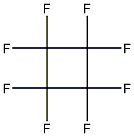| Identification |
| Name: | Cyclobutane,1,1,2,2,3,3,4,4-octafluoro- |
| Synonyms: | Cyclobutane, octafluoro-;Octafluorocyclobutane;Perfluorocyclobutane;Freon C-318;FC-C 318;Propellant C318;R-C 318;1,1,2,2,3,3,4,4-Octafluorocyclobutane; |
| CAS: | 115-25-3 |
| EINECS: | 204-075-2 |
| Molecular Formula: | C4F8 |
| Molecular Weight: | 200.03 |
| InChI: | InChI=1/C4F8/c5-1(6)2(7,8)4(11,12)3(1,9)10 |
| Molecular Structure: |
 |
| Properties |
| Transport: | UN 1976 |
| Flash Point: | °C |
| Density: | 1.48 |
| Refractive index: | 1.217 |
| Water Solubility: | Solubility (H20) :140 mg/l |
| Solubility: | Solubility (H20) :140 mg/l |
| Appearance: | Colorless gas with ethereal odor |
| Specification: |
Cyclooctafluorobutane (115-25-3) is a colorless nonflammable gas. It may be harmful by asphyxiation. Exposure of the container to prolonged heat or fire can cause it to rupture violently and rocket. It is used to make other chemicals. Reactivity profile Cyclooctafluorobutane (115-25-3) is chemically inert in many situations, but can react violently with strong reducing agents such as the very active metals and the active metals. They suffer oxidation with strong oxidizing agents and under extremes of temperature.
Health Hazard Vapors may cause dizziness or asphyxiation without warning. Vapors from liquefied gas are initially heavier than air and spread along ground. Contact with gas or liquefied gas may cause burns, severe injury and/or frostbite. Fire may produce irritating, corrosive and/or toxic gases.
|
| Report: |
EPA Genetic Toxicology Program. Reported in EPA TSCA Inventory.
|
| Packinggroup: | O53 |
| Flash Point: | °C |
| Safety Data |
| Hazard Symbols |
 Xi: Irritant
Xi: Irritant
|
| |
 |